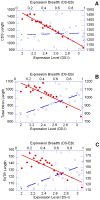Mutational biases and selective forces shaping the structure of Arabidopsis genes
- PMID: 19633720
- PMCID: PMC2712092
- DOI: 10.1371/journal.pone.0006356
Mutational biases and selective forces shaping the structure of Arabidopsis genes
Abstract
Recently features of gene expression profiles have been associated with structural parameters of gene sequences in organisms representing a diverse set of taxa. The emerging picture indicates that natural selection, mediated by gene expression profiles, has a significant role in determining genic structures. However the current situation is less clear in plants as the available data indicates that the effect of natural selection mediated by gene expression is very weak. Moreover, the direction of the patterns in plants appears to contradict those observed in animal genomes. In the present work we analized expression data for >18000 Arabidopsis genes retrieved from public datasets obtained with different technologies (MPSS and high density chip arrays) and compared them with gene parameters. Our results show that the impact of natural selection mediated by expression on genes sequences is significant and distinguishable from the effects of regional mutational biases. In addition, we provide evidence that the level and the breadth of gene expression are related in opposite ways to many structural parameters of gene sequences. Higher levels of expression abundance are associated with smaller transcripts, consistent with the need to reduce costs of both transcription and translation. Expression breadth, however, shows a contrasting pattern, i.e. longer genes have higher breadth of expression, possibly to ensure those structural features associated with gene plasticity. Based on these results, we propose that the specific balance between these two selective forces play a significant role in shaping the structure of Arabidopsis genes.
Conflict of interest statement
Figures




Similar articles
-
In plants, expression breadth and expression level distinctly and non-linearly correlate with gene structure.Biol Direct. 2009 Nov 21;4:45; discussion 45. doi: 10.1186/1745-6150-4-45. Biol Direct. 2009. PMID: 19930585 Free PMC article.
-
The regulatory code for transcriptional response diversity and its relation to genome structural properties in A. thaliana.PLoS Genet. 2007 Feb 9;3(2):e11. doi: 10.1371/journal.pgen.0030011. Epub 2006 Dec 6. PLoS Genet. 2007. PMID: 17291162 Free PMC article.
-
AGRIS: Arabidopsis gene regulatory information server, an information resource of Arabidopsis cis-regulatory elements and transcription factors.BMC Bioinformatics. 2003 Jun 23;4:25. doi: 10.1186/1471-2105-4-25. Epub 2003 Jun 23. BMC Bioinformatics. 2003. PMID: 12820902 Free PMC article.
-
Purifying selection acts on coding and non-coding sequences of paralogous genes in Arabidopsis thaliana.BMC Genomics. 2016 Jun 13;17:456. doi: 10.1186/s12864-016-2803-2. BMC Genomics. 2016. PMID: 27296049 Free PMC article.
-
Genetic mechanisms and evolutionary significance of natural variation in Arabidopsis.Nature. 2006 Jun 22;441(7096):947-52. doi: 10.1038/nature04878. Nature. 2006. PMID: 16791187 Review.
Cited by
-
Variation of gene expression in plants is influenced by gene architecture and structural properties of promoters.PLoS One. 2019 Mar 25;14(3):e0212678. doi: 10.1371/journal.pone.0212678. eCollection 2019. PLoS One. 2019. PMID: 30908494 Free PMC article.
-
Rates of evolution in stress-related genes are associated with habitat preference in two Cardamine lineages.BMC Evol Biol. 2012 Jan 18;12:7. doi: 10.1186/1471-2148-12-7. BMC Evol Biol. 2012. PMID: 22257588 Free PMC article.
-
Gene expression: sizing it all up.Front Genet. 2011 Oct 17;2:70. doi: 10.3389/fgene.2011.00070. eCollection 2011. Front Genet. 2011. PMID: 22303365 Free PMC article.
-
New insights into the interplay between codon bias determinants in plants.DNA Res. 2015 Dec;22(6):461-70. doi: 10.1093/dnares/dsv027. Epub 2015 Nov 5. DNA Res. 2015. PMID: 26546225 Free PMC article.
-
Comparative Study of Pine Reference Genomes Reveals Transposable Element Interconnected Gene Networks.Genes (Basel). 2020 Oct 16;11(10):1216. doi: 10.3390/genes11101216. Genes (Basel). 2020. PMID: 33081418 Free PMC article.
References
-
- Castillo-Davis CI, Mekhedov SL, Hartl DL, Koonin EV, Kondrashov FA. Selection for short introns in highly expressed genes. Nat Genet. 2002;31:415–418. - PubMed
-
- Vinogradov AE. Compactness of human housekeeping genes: selection for economy or genomic design? Trends Genet. 2004;20:248–253. - PubMed
-
- Eisenberg E, Levanon EY. Human housekeeping genes are compact. Trends Genet. 2003;19:362–365. - PubMed
Publication types
MeSH terms
Substances
LinkOut - more resources
Full Text Sources

